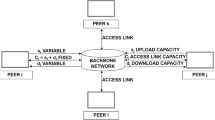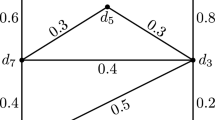Abstract
This paper focuses on the problem of increasing the traffic capacity (volume of admissible traffic) of broadcast and multicast flows in a wireless mesh network (WMN). We study and suggest routing strategies where the process of constructing the forwarding tree considers three distinct features: (a) the ability of individual mesh nodes to perform link-layer broadcasts at multiple rates, (b) the wireless broadcast advantage, whereby a single broadcast transmission covers multiple neighboring receivers and (c) the residual transmission capacity at a WMN node, subject to intereference-based constraints from existing traffic flows in its neighborhood. Our metric of interest is the total number of broadcast and multicast flows that can be admitted into the network, without resulting in unacceptable degradation in metrics such as packet loss and dissemination latency. Our discrete event simulations show that the broadcast tree construction heuristic which takes both transmission rate and residual bandwidth into account out-performs those that do not. Building on our work on resource-aware broadcast tree construction, we propose a resource-aware multicast tree construction algorithm which exploits the multiple link-layer rates, the wireless broadcast advantage and the amount of resources available. Simulation results show that this algorithm performs better than heuristics based on pruning a broadcast tree or shortest path trees.











Similar content being viewed by others
Notes
The case where the channel condition is time-varying is left for future work.
Our analysis, which is aimed at understanding the fundamental issues associated with multi-rate transmissions, assumes that L i represents the total traffic load of F i , such that \(\frac{L_i}{\rho}\) represents the total transmission time. For precise computation, L i should be adjusted to include the various overheads (network, MAC, PHY) associated with a specific transmission technology.
We also assume that the load for all flows are fixed and known before hand at the time of admission control and route establishment.
Given a graph (V,E) where V is the set of nodes and E is the set of edges. An independent set I is a subset of V such that no two elements in I are connected by an edge.
Let Δ i denote the out-degree of node v i , then the maximum number of nodes in a unicast CG and multicast CG are, respectively, \(\sum_{v_i \in V} \Delta_i\) (which is equal to the number of directed edges in the graph) and \(\sum_{v_i \in V} (2^{\Delta_i}-1)\).
References
UNSW (2006) Efficient distribution of content in multi-rate, multi-channel wireless mesh networks. The Aiolos Project, http://www.cse.unsw.edu.au/∼aiolos/index.html
Akyildiz I, Wang X, Wang W (2005) Wireless mesh networks: a survey. Elesevier Computer Networks
Anker T, Dolev D, Eliaspur Y (2004) Off-piste QoS-aware routing protocol. Proceedings of IEEE ICNP
Awerbuch B, Holmer D, Rubens H (2004) High throughput route selection in multi-rate ad hoc wireless networks. Lect Notes Comput Sci 2928:253–270
Bicket J, Aguayo D, Biswas S, Morris R (2005) Architecture and evaluation of an unplanned 802.11b mesh network. Proc. of MOBICOM
Camp J, Robinson J, Steger C, Knightly E (2006) Measurement-driven deployment of a two-tier urban mesh access network. Proc. of ACM/Usenix Mobisys
Cartigny J, Simplot D, Stojmenovic I (2003) Localized minimum-energy broadcasting in ad-hoc networks. Proc. of INFOCOM, p 2210
Chaporkar P, Sarkar S (2005) Wireless multicast: theory and approaches. IEEE Trans Inf Theory 51(6), June
Chou CT, Misra A, Qadir J (2006) Low latency broadcast in multi-rate wireless mesh networks. IEEE journal on selected areas in communications (Special issue on multi-hop wireless mesh networks), 24(11):2081–2091, November
Chou CT, Liu BH, Misra A (2007) Maximizing broadcast and multicast traffic load through link-rate diversity in wireless mesh networks. In: Proc. IEEE international symposium on a world of wireless, mobile and multimedia networks (WoWMoM)
Draves R, Padhye J, Zill B (2004) Routing in multi-radio, multi-hop wireless mesh networks. In: Mobicom, pp 114–128
Gui C, Mohapatra P (2004) Scalable multicasting in mobile ad hoc networks. In: INFOCOM, p 2119
Gupta P, Kumar PR (2000) The capacity of wireless networks. IEEE Trans Inf Theory, March
Gupta R, Musacchio J, Walrand J (2007) Sufficient rate constraints for QoS flows in Ad-Hoc networks. Ad Hoc Networks 5(4):429–443, May
IEEE Std 802.11a-1999 (1999) Wireless LAN medium access control (MAC) and physical layer (PHY) specifications: high-speed physical layer in the 5 GHZ band
Jain K, Padhye J, Padmanabhan VN, Qiu L (2003) Impact of interference on multi-hop wireless network performance. Proc of ACM Mobicom, p. 66–80
Kodialam M, Nandagopal T (2005) Characterizing achievable rates in multi-hop wireless mesh networks with orthogonal channels. IEEE/ACM Trans Netw (TON) 13(4):868–880, August
Liu BH, Chou CT, Misra A, Jha S (2007) Resource-aware broadcast and multicast in multi-rate wireless mesh networks. Technical Report, School of Computer Science and Engineering, University of New South Wales. ftp://ftp.cse.unsw.edu.au/pub/doc/papers/UNSW/0714.pdf
Lou W, Wu J (2002) On reducing broadcast redundancy in ad hoc wireless networks. IEEE Trans Mob Comput 1:111
Qualnet, http://www.qualnet.com
Qadir J, Chou CT, Misra A (2006) Exploiting rate diversity for broadcasting in wireless mesh networks. In: Proc. IEEE conference on local computer networks (LCN)
Qadir J, Misra A, Chou CT (2006) Minimum latency broadcasting in multi-radio multi-channel multi-rate wireless meshes. Proc. of 3rd IEEE communications society conference on sensor, mesh and ad hoc communications and networks (SECON), September
Tang J, Xue G, Chandler C (2005) Interference-aware routing and bandwidth allocation for QoS provisioning in multihop wireless networks. Wirel Commun Mob Comput J 5(8):933–943
Tebbe H, Kassler A, Ruiz P (2006) QoS-aware mesh construction to enhance multicast routing in mobile ad hoc networks. Proceedings of intersense 2006, May
Wieselthier JE, Nguyen GD, Ephremides A (2000) On the construction of energy-efficient broadcast and multicast trees in wireless networks. In: INFOCOM
Xue Y, Li B, Nahrstedt K (2006) Optimal resource allocation in wireless ad hoc networks: a price-based approach. IEEE Trans Mob Comput 5(4), April
Zhao X, Chou CT, Guo J, Jha S (2006) Protecting multicast sessions inwireless mesh networks. Proc. IEEE conference on local computer networks (LCN), November
Author information
Authors and Affiliations
Corresponding author
Additional information
This work was supported by the Australian Research Council Discovery Project grant DP0664791.
This work was done when Dr. Bao Hua Liu was employed as a Senior Research Associate at the University of New South Wales, Australia.
Archan Misra’s research is continuing through participation in the International Technology Alliance sponsored by the U.S. Army Research Laboratory and the U.K. Ministry of Defence.
Rights and permissions
About this article
Cite this article
Liu, B.H., Chou, C.T., Misra, A. et al. Rate-Diversity and Resource-Aware Broadcast and Multicast in Multi-rate Wireless Mesh Networks. Mobile Netw Appl 13, 38–53 (2008). https://doi.org/10.1007/s11036-008-0029-5
Received:
Accepted:
Published:
Issue Date:
DOI: https://doi.org/10.1007/s11036-008-0029-5




